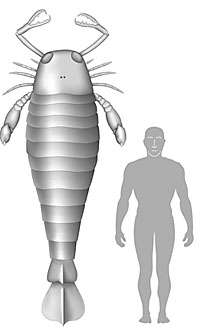 | This illustration shows the size of the giant sea scorpion relative to a human man. The eight-foot-long creature lived between 460 and 244 million years ago. The fossil claw is a foot-and-a-half long. |
The gigantic fossil claw of a 390 million-year-old sea scorpion recently found
in Germany shows that ancient arthropods — spiders, insects, crabs and
the like — were surprisingly larger than their modern-day counterparts. — By Janet Emanuel
T H I S
ENDOWED PROFESSORSHIPS
Fossil from giant sea scorpion found
“Imagine an eight-foot-long scorpion,” says O. Erik Tetlie, postdoctoral
associate in Yale’s Department of Geology and Geophysics, and an author
of the report online in Royal Society Biology Letters. “The claw itself
is a foot-and-a-half long — indicating that this ancient arthropod is much
larger than previous estimates — and certainly the largest seen to date.”
Colleague and co-author Markus Poschmann discovered the fossil claw from this
ancient sea scorpion, Jaekelopterus rhenaniae, in a quarry near Prüm in
Germany. The sea scorpion, which lived between 460 and 255 million years ago,
is the latest addition to a group of extinct creatures that scientists have
known about for some time that includes the largest arthropods ever found,
based on both body fossils and trace fossils. According to the authors, it
is believed that these extinct aquatic creatures are the ancestors of modern
scorpions and spiders.
Tetlie notes that geologists are debating the reasons for the evolution
of these giant arthropods, “While some believe they evolved with the
higher levels of atmospheric oxygen that were present in the past, some say
they evolved in a parallel ‘arms race’ with early armoured fish
that were their likely prey,” he says.
Lead author Simon Braddy from the Department of Earth Sciences at the University
of Bristol, United Kingdom, says: “This is an amazing discovery. We have
known for some time that the fossil record yields monster millipedes, super-sized
scorpions, colossal cockroaches and jumbo dragonflies, but we never realized,
until now, just how big some of these ancient creepy-crawlies were.”
The Norwegian Research Council funded Tetlie’s work on the evolutionary
relationships of the ancient organisms.
 W E E K ' S
W E E K ' S S T O R I E S
S T O R I E S![]()
 Fossil from giant sea scorpion found
Fossil from giant sea scorpion found![]()
![]()
 Paleontologist named next Peabody director
Paleontologist named next Peabody director![]()
![]()
 Yale senior and Law School student win Rhodes Scholarships
Yale senior and Law School student win Rhodes Scholarships![]()
![]()
 Renovation of Yale Bowl celebrated at The Game
Renovation of Yale Bowl celebrated at The Game![]()
 Victor Vroom is named the inaugural BearingPoint Professor
Victor Vroom is named the inaugural BearingPoint Professor![]()
 Jonathan Feinstein appointed the John G. Searle Professor
Jonathan Feinstein appointed the John G. Searle Professor![]()
![]()
 Going the Distance: Scientist takes students to the Amazon . . .
Going the Distance: Scientist takes students to the Amazon . . .![]()
![]()
 Kissinger to take part in symposium on . . .
Kissinger to take part in symposium on . . .![]()
![]()
 Venezuela’s future under Hugo Chávez will be explored . . .
Venezuela’s future under Hugo Chávez will be explored . . .![]()
![]()
 Museum celebrates 200th anniversary of fall of ‘Weston’ meteorite
Museum celebrates 200th anniversary of fall of ‘Weston’ meteorite![]()
![]()
 An old classic is seen through a modern lens at Yale Rep
An old classic is seen through a modern lens at Yale Rep![]()
![]()
 Babies’ preference for altruists suggests social evaluation . . .
Babies’ preference for altruists suggests social evaluation . . .![]()
![]()
 Monsanto expands support for center’s plant research
Monsanto expands support for center’s plant research![]()
![]()
 A likeness
A likeness![]()
![]()
 Symposium will examine the architecture of Yale’s 22 libraries
Symposium will examine the architecture of Yale’s 22 libraries![]()
![]()
 Special events to highlight holiday season in New Haven
Special events to highlight holiday season in New Haven![]()
![]()
 Gallery of gifts
Gallery of gifts![]()
![]()
 Back to ‘The City’
Back to ‘The City’![]()
![]()
 Memorial service for Dr. Melvin Lewis
Memorial service for Dr. Melvin Lewis![]()
![]()
 Yale Books in Briefs
Yale Books in Briefs![]()
![]()
 Campus Notes
Campus Notes![]()
Bulletin Home |
| Visiting on Campus
Visiting on Campus |
| Calendar of Events
Calendar of Events |
| In the News
In the News![]()
Bulletin Board |
| Classified Ads
Classified Ads |
| Search Archives
Search Archives |
| Deadlines
Deadlines![]()
Bulletin Staff |
| Public Affairs
Public Affairs |
| News Releases
News Releases |
| E-Mail Us
E-Mail Us |
| Yale Home
Yale Home